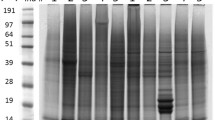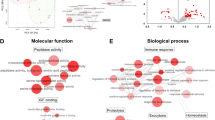Abstract
Purpose
Clinical glaucoma is difficult to assess in terms of molecular pathophysiology, prompting studies in experimental models of glaucoma. The purpose of this study was to investigate quantitative changes in retinal protein expression at the onset of experimental glaucoma in rats. Analyzing the proteome provides a suitable tool to decipher the pathophysiological processes in glaucomatous degeneration.
Methods
Thermic cauterization of episcleral veins was utilized to elevate the intraocular pressure in Sprague Dawley rats. Morphological changes were surveyed on a cellular level with a staining of Brn3a-positive cells. The retinal nerve fiber layer was investigated using optical coherence tomography (OCT, Heidelberg Engineering) and the optic nerve was analyzed by an axonal grading system. Mass spectrometry-featured quantitative proteomics and immunohistochemical staining was used to identify specifically altered proteins in the course of intraocular pressure elevation and initial neurodegeneration. Proteomic data were further analyzed with Ingenuity Pathway Analysis and Cytoscape to analyze further molecular associations.
Results
The intraocular pressure rose significantly (p < 0.001) for the follow-up period of 3 weeks after which animals were sacrificed. Eyes exposed to an elevated intraocular pressure showed an initial decrease of retinal ganglion cells, retinal nerve fiber layer (p < 0.05) and an impairment of the optic nerve (p < 0.01). Mass spectrometry led to the identification and quantification of 931 retinal proteins, whereas 32 were considerably altered. Bioinformatics-assisted clustering revealed that a majority of these proteins are functionally associated with cell differentiation, apoptosis and stress response. The creation of an interactive protein network showed that numerous altered proteins are connected regarding their cellular function. Protein kinase b, mitogen-activated protein kinase 1 and the NF-κB complex seem to be essential molecules in this context.
Conclusions
In conclusion, these results provide further lines of evidence that substantial molecular changes occur at the onset of the disease, identifying potential key players, which might be useful as biomarkers for diagnostics and development of medical treatment in the future.







Similar content being viewed by others
References
Weinreb RN, Aung T, Medeiros FA (2014) The pathophysiology and treatment of glaucoma: a review. JAMA 311:1901–1911. doi:10.1001/jama.2014.3192
Bhattacharya SK, Lee RK, Grus FH, Seventh APORICWG (2013) Molecular biomarkers in glaucoma. Invest Ophthalmol Vis Sci 54:121–131. doi:10.1167/iovs.12-11067
Pieragostino D, Agnifili L, Fasanella V, D’Aguanno S, Mastropasqua R, Di Ilio C, Sacchetta P, Urbani A, Del Boccio P (2013) Shotgun proteomics reveals specific modulated protein patterns in tears of patients with primary open angle glaucoma naive to therapy. Mol BioSyst 9:1108–1116. doi:10.1039/c3mb25463a
Kliuchnikova AA, Samokhina NI, Ilina IY, Karpov DS, Pyatnitskiy MA, Kuznetsova KG, Toropygin IY, Kochergin SA, Alekseev IB, Zgoda VG, Archakov AI, Moshkovskii SA (2016) Human aqueous humor proteome in cataract, glaucoma, and pseudoexfoliation syndrome. Proteomics 16:1938–1946. doi:10.1002/pmic.201500423
Yang X, Hondur G, Li M, Cai J, Klein JB, Kuehn MH, Tezel G (2015) Proteomics analysis of molecular risk factors in the ocular hypertensive human retina. Invest Ophthalmol Vis Sci 56:5816–5830. doi:10.1167/iovs.15-17294
Wilkins MR, Sanchez JC, Gooley AA, Appel RD, Humphery-Smith I, Hochstrasser DF, Williams KL (1996) Progress with proteome projects: why all proteins expressed by a genome should be identified and how to do it. Biotechnology & genetic engineering reviews 13:19–50
Zhao Y, Lee WN, Xiao GG (2009) Quantitative proteomics and biomarker discovery in human cancer. Expert review of proteomics 6:115–118. doi:10.1586/epr.09.8
Elliott MH, Smith DS, Parker CE, Borchers C (2009) Current trends in quantitative proteomics. Journal of mass spectrometry : JMS 44:1637–1660. doi:10.1002/jms.1692
Kobayashi T, Ishida K, Yoshie H (2016) Increased expression of interleukin-6 (IL-6) gene transcript in relation to IL-6 promoter hypomethylation in gingival tissue from patients with chronic periodontitis. Arch Oral Biol 69:89–94. doi:10.1016/j.archoralbio.2016.05.018
Shimamoto S, Ijiri D, Nakashima K, Kawaguchi M, Ishimaru Y, Furukawa A, Ohtsuka A (2016) Clenbuterol changes phosphorylated FOXO1 localization and decreases protein degradation in the sartorius muscle of neonatal chicks. Biosci Biotechnol Biochem 80:1499–1504. doi:10.1080/09168451.2016.1158629
Iglesias-Gato D, Wikstrom P, Tyanova S, Lavallee C, Thysell E, Carlsson J, Hagglof C, Cox J, Andren O, Stattin P, Egevad L, Widmark A, Bjartell A, Collins CC, Bergh A, Geiger T, Mann M, Flores-Morales A (2016) The proteome of primary prostate cancer. Eur Urol 69:942–952. doi:10.1016/j.eururo.2015.10.053
Shareef SR, Garcia-Valenzuela E, Salierno A, Walsh J, Sharma SC (1995) Chronic ocular hypertension following episcleral venous occlusion in rats. Exp Eye Res 61:379–382
Funke S, Perumal N, Beck S, Gabel-Scheurich S, Schmelter C, Teister J, Gerbig C, Gramlich OW, Pfeiffer N, Grus FH (2016) Glaucoma related proteomic alterations in human retina samples. Scientific reports 6:29759. doi:10.1038/srep29759
Cox J, Mann M (2008) MaxQuant enables high peptide identification rates, individualized p.P.B.-range mass accuracies and proteome-wide protein quantification. Nat Biotechnol 26:1367–1372. doi:10.1038/nbt.1511
Giovingo M, Nolan M, McCarty R, Pang IH, Clark AF, Beverley RM, Schwartz S, Stamer WD, Walker L, Grybauskas A, Skuran K, Kuprys PV, Yue BY, Knepper PA (2013) sCD44 overexpression increases intraocular pressure and aqueous outflow resistance. Mol Vis 19:2151–2164
Kita K, Sugita K, Sato C, Sugaya S, Sato T, Kaneda A (2016) Extracellular release of Annexin A2 is enhanced upon oxidative stress response via the p38 MAPK pathway after low-dose X-ray irradiation. Radiation research. doi:10.1667/RR14277.1
Wang CY, Lin CF (2014) Annexin A2: its molecular regulation and cellular expression in cancer development. Dis Markers 2014:308976. doi:10.1155/2014/308976
Kamisasanuki T, Tokushige S, Terasaki H, Khai NC, Wang Y, Sakamoto T, Kosai K (2011) Targeting CD9 produces stimulus-independent antiangiogenic effects predominantly in activated endothelial cells during angiogenesis: a novel antiangiogenic therapy. Biochem Biophys Res Commun 413:128–135. doi:10.1016/j.bbrc.2011.08.068
Tanihara H, Hangai M, Sawaguchi S, Abe H, Kageyama M, Nakazawa F, Shirasawa E, Honda Y (1997) Up-regulation of glial fibrillary acidic protein in the retina of primate eyes with experimental glaucoma. Arch Ophthalmol 115:752–756
Ghaleb AM, Bialkowska AB, Snider AJ, Gnatenko DV, Hannun YA, Yang VW, Schmidt VA (2015) IQ motif-containing GTPase-activating protein 2 (IQGAP2) is a novel regulator of colonic inflammation in mice. PLoS One 10:e0129314. doi:10.1371/journal.pone.0129314
Brisac C, Salloum S, Yang V, Schaefer EA, Holmes JA, Chevaliez S, Hong J, Carlton-Smith C, Alatrakchi N, Kruger A, Lin W, Chung RT (2016) IQGAP2 is a novel interferon-alpha antiviral effector gene acting nonconventionally through the NF-kappaB pathway. Journal of hepatology. doi:10.1016/j.jhep.2016.06.028
Syed NA, Andersen PL, Warrington RC, Xiao W (2006) Uev1A, a ubiquitin conjugating enzyme variant, inhibits stress-induced apoptosis through NF-kappaB activation. Apoptosis : an international journal on programmed cell death 11:2147–2157. doi:10.1007/s10495-006-0197-3
Goodwin BL, Solomonson LP, Eichler DC (2004) Argininosuccinate synthase expression is required to maintain nitric oxide production and cell viability in aortic endothelial cells. J Biol Chem 279:18353–18360. doi:10.1074/jbc.M308160200
Mori J, Tanikawa C, Funauchi Y, Lo PH, Nakamura Y, Matsuda K (2016) Cystatin C as a p53-inducible apoptotic mediator that regulates cathepsin L activity. Cancer Sci 107:298–306. doi:10.1111/cas.12881
Liang X, Nagai A, Terashima M, Sheikh AM, Shiota Y, Mitaki S, Kim SU, Yamaguchi S (2011) Cystatin C induces apoptosis and tyrosine hydroxylase gene expression through JNK-dependent pathway in neuronal cells. Neurosci Lett 496:100–105. doi:10.1016/j.neulet.2011.03.091
Stasi K, Nagel D, Yang X, Ren L, Mittag T, Danias J (2007) Ceruloplasmin upregulation in retina of murine and human glaucomatous eyes. Invest Ophthalmol Vis Sci 48:727–732. doi:10.1167/iovs.06-0497
Farkas RH, Chowers I, Hackam AS, Kageyama M, Nickells RW, Otteson DC, Duh EJ, Wang C, Valenta DF, Gunatilaka TL, Pease ME, Quigley HA, Zack DJ (2004) Increased expression of iron-regulating genes in monkey and human glaucoma. Invest Ophthalmol Vis Sci 45:1410–1417
Wang SY, Singh K, Lin SC (2012) The association between glaucoma prevalence and supplementation with the oxidants calcium and iron. Invest Ophthalmol Vis Sci 53:725–731. doi:10.1167/iovs.11-9038
Wang SY, Singh K, Lin SC (2013) Glaucoma prevalence and the intake of iron and calcium in a population-based study. Curr Eye Res 38:1049–1056. doi:10.3109/02713683.2013.803124
Ganguly S, Mitra A, Sarkar S (2014) Role of alpha-crystallin B in regulation of stress induced cardiomyocyte apoptosis. Cardiovasc Hematol Agents Med Chem 12:60–65
Coop A, Wiesmann KE, Crabbe MJ (1998) Translocation of beta crystallin in neural cells in response to stress. FEBS Lett 431:319–321
Bakthisaran R, Akula KK, Tangirala R, Rao Ch M (2016) Phosphorylation of alphaB-crystallin: role in stress, aging and patho-physiological conditions. Biochim Biophys Acta 1860:167–182. doi:10.1016/j.bbagen.2015.09.017
Piri N, Song M, Kwong JM, Caprioli J (2007) Modulation of alpha and beta crystallin expression in rat retinas with ocular hypertension-induced ganglion cell degeneration. Brain Res 1141:1–9. doi:10.1016/j.brainres.2006.11.095
Head MW, Corbin E, Goldman JE (1993) Overexpression and abnormal modification of the stress proteins alpha B-crystallin and HSP27 in Alexander disease. Am J Pathol 143:1743–1753
Renkawek K, de Jong WW, Merck KB, Frenken CW, van Workum FP, Bosman GJ (1992) Alpha B-crystallin is present in reactive glia in Creutzfeldt-Jakob disease. Acta Neuropathol 83:324–327
Joachim SC, Bruns K, Lackner KJ, Pfeiffer N, Grus FH (2007) Antibodies to alpha B-crystallin, vimentin, and heat shock protein 70 in aqueous humor of patients with normal tension glaucoma and IgG antibody patterns against retinal antigen in aqueous humor. Curr Eye Res 32:501–509. doi:10.1080/02713680701375183
Naskar R, Thanos S (2006) Retinal gene profiling in a hereditary rodent model of elevated intraocular pressure. Mol Vis 12:1199–1210
Fischer D, Hauk TG, Muller A, Thanos S (2008) Crystallins of the beta/gamma-superfamily mimic the effects of lens injury and promote axon regeneration. Mol Cell Neurosci 37:471–479. doi:10.1016/j.mcn.2007.11.002
Sreekumar PG, Kannan R, Kitamura M, Spee C, Barron E, Ryan SJ, Hinton DR (2010) alphaB crystallin is apically secreted within exosomes by polarized human retinal pigment epithelium and provides neuroprotection to adjacent cells. PLoS One 5:e12578. doi:10.1371/journal.pone.0012578
Bohm MR, Melkonyan H, Oellers P, Thanos S (2013) Effects of crystallin-beta-b2 on stressed RPE in vitro and in vivo. Graefes Arch Clin Exp Ophthalmol 251:63–79. doi:10.1007/s00417-012-2157-7
Fischer D, Heiduschka P, Thanos S (2001) Lens-injury-stimulated axonal regeneration throughout the optic pathway of adult rats. Exp Neurol 172:257–272. doi:10.1006/exnr.2001.7822
Lewis GP, Fisher SK (2003) Up-regulation of glial fibrillary acidic protein in response to retinal injury: its potential role in glial remodeling and a comparison to vimentin expression. Int Rev Cytol 230:263–290
Yi T, Kim HJ, Cho JY, Woo KM, Ryoo HM, Kim GS, Baek JH (2006) Tetraspanin CD9 regulates osteoclastogenesis via regulation of p44/42 MAPK activity. Biochem Biophys Res Commun 347:178–184. doi:10.1016/j.bbrc.2006.06.061
Hong IK, Kim YM, Jeoung DI, Kim KC, Lee H (2005) Tetraspanin CD9 induces MMP-2 expression by activating p38 MAPK, JNK and c-Jun pathways in human melanoma cells. Exp Mol Med 37:230–239. doi:10.1038/emm.2005.31
Author information
Authors and Affiliations
Corresponding author
Ethics declarations
Funding
The Deutsche Forschungsgemeinschaft (DFG) provided financial support in the form of a grant for this study (PR1569/1–1). The sponsor had no role in the design or conduct of this research.
Conflict of interest
All authors certify that they have no affiliations with or involvement in any organization or entity with any financial interest (such as honoraria; educational grants; participation in speakers’ bureaus; membership, employment, consultancies, stock ownership, or other equity interest; and expert testimony or patent-licensing arrangements), or non-financial interest (such as personal or professional relationships, affiliations, knowledge or beliefs) in the subject matter or materials discussed in this manuscript.
Animal experiments
Ethical approval: All applicable international, national, and/or institutional guidelines for the care and use of animals were followed.
Rights and permissions
About this article
Cite this article
Anders, F., Teister, J., Funke, S. et al. Proteomic profiling reveals crucial retinal protein alterations in the early phase of an experimental glaucoma model. Graefes Arch Clin Exp Ophthalmol 255, 1395–1407 (2017). https://doi.org/10.1007/s00417-017-3678-x
Received:
Revised:
Accepted:
Published:
Issue Date:
DOI: https://doi.org/10.1007/s00417-017-3678-x




